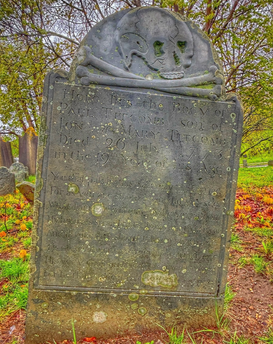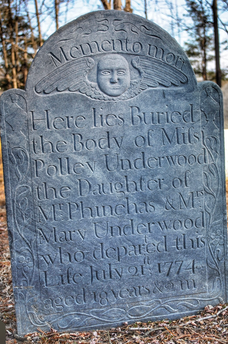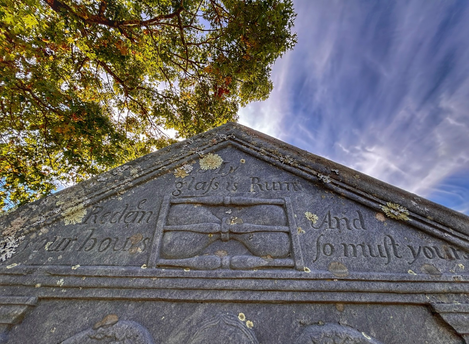Unveiling the Symbolism of Colonial-Era Gravestones - Part Two
- B
- Jan 29
- 5 min read
Cherubs on Colonial-Era Tombstones: Symbolism and Significance
In the early American colonies, death was an ever-present reality. With high mortality rates and low life expectancy, colonists sought ways to cope with the inevitability of death. One way they did this was through tombstone symbolism, particularly the depiction of Cherubs. These winged figures, typically depicted as infants or young children, held significant meaning and conveyed messages about mortality, innocence, and the afterlife.
Origins and Meaning:
Cherubs originated in ancient Jewish and Christian traditions, representing the attendants of God’s throne (Metropolitan Museum of Art, n.d.). In colonial America, cherubs were adopted as a symbol of innocence and purity, often used to commemorate the deaths of children or young adults (Ludwig, 1966).
The use of cherubs on tombstones also reflected the colonial American view of death as a transition to the afterlife. Cherubs were seen as guides or escorts for the deceased, accompanying them on their journey to heaven (Farrell, 1980).
Examples from Colonial-Era Cemeteries:
Cherubs can be found on tombstones throughout colonial America, from the oldest burial grounds in New England to those in the South. Some notable examples include:
The Granary Burying Ground in Boston, Massachusetts, is where visitors can find cherub-adorned tombstones marking the grave of a young child (Boston Historical Society, n.d.).
The Old Burying Point Cemetery in Salem, Massachusetts, features a tombstone with a cherub and the inscription “Innocence and Beauty soon fade” (Salem Witch Museum, n.d.).
The St. Michael’s Episcopal Church Cemetery in Charleston, South Carolina, where a cherub-topped tombstone commemorates the death of a young woman (St. Michael’s Episcopal Church, n.d).
Variations and Symbolism:
The depiction of cherubs on colonial-era tombstones varied, with some carvers adding additional symbols or using different materials, such as slate or marble (Tashjian, 1974). Cherub symbolism also evolved, reflecting changes in colonial American culture and attitudes toward death.
In some cases, cherubs were used in conjunction with other symbols, such as skulls or crossbones, to reinforce the message of mortality (Ludwig, 1966). In other instances, cherubs were used to commemorate the deaths of adults, emphasizing the idea of innocence and purity in the face of death (Farrell, 1980).
Conclusion:
The use of cherubs on colonial-era tombstones highlights colonial American culture's complex and multifaceted nature. While cherubs symbolized innocence and purity, they also reflected the harsh realities of life and death in colonial America, where mortality rates were high and life expectancy was extremely low. As such, the study of cherubs on colonial-era tombstones offers a unique window into the values, beliefs, and experiences of colonial Americans and serves as a reminder of the enduring power of symbolism and art to convey the human experience.
Beyond the Pirate’ Emelem: Uncovering the Symbolism of Skull and Crossbones on Colonial-Era Tombstones
The Skull and crossbones, a symbol often associated with piracy and danger, hold a more nuanced meaning in the context of colonial-era tombstones. Far from being a warning or a sign of ill repute, the skull, and crossbones were a common motif used to convey the inevitability of death and the transience of human life.
Death was ubiquitous in colonial America, and the skull and crossbones served as a poignant reminder of mortality (Stannard, 1977). This symbol was often used in conjunction with other motifs, such as the hourglass and the winged soul, to emphasize the fleeting nature of human existence.
Examples from Colonial-Era Cemeteries
The skull and crossbones can be found on tombstones throughout colonial America and the southern colonies. Some examples include:
The Copps Hill Burying Ground in Boston, Massachusetts, where visitors can find a tombstone featuring a skull and crossbones, accompanied by the inscription “Memento Mori” (Boston Historical Society, n.d.).
The Old Burying Point Cemetery in Salem, Massachusetts, which a skull and crossbones, surrounded by other symbols of mortality (Salem Witch Museum, n.d.).
The Magnolia Cemetery in Charleston, South Carolina, where a tombstone featuring a skull and crossbones commemorates the death of a younger woman (Magnolia Cemetery Trust, n.d.).
The Evolution of the Skull and Crossbones Motif
Over time, the skull and crossbones motif underwent significant changes, reflecting shifting attitudes toward death and mortality. In the early colonial period, the skull and crossbones were often depicted in a more gruesome and explicit manner, emphasizing the horrors of death (Ludwig, 1966).
However, as the colonial period progressed, the skull and crossbones motif became more stylized and less explicit, often featuring a more Serengeti and peaceful depiction of death (Farrell, 1980).
Conclusion
The skull and crossbones on colonial-era tombstones powerfully remind us of the transience of human life and the inevitability of death. Far from being a morbid or macabre symbol, they were a poignant and thought-provoking motif that encouraged the living to contemplate their own mortality.
The skull and crossbones motif used on tombstones provides a unique window into colonial America's cultural and symbolic landscape. It highlights the complex and multifaceted nature of human attitudes toward death and mortality.
The Hourglass Motif on Colonial-Era Tombstones: A Symbol of Transience of Mortality
In Colonial America, the hourglass was a ubiquitous symbol on tombstones, poignantly reminding people of the transience of human life. This motif, often depicted with the words “Tempus fugit” (Time flees), emphasizes mortality's fleeting nature and death's inevitability.
The hourglass symbolizes the passage of time, with the sand flowing from the top to the bottom, representing the irreversible flow of life (Cressy, 1997). This motif was often used in conjunction with other symbols, such as the skull and crossbones, to reinforce the message of mortality.
Examples of hourglasses on colonial-era tombstones can be found in various cemeteries throughout the American colonies. For instance:
The Myles Standish Burial Ground in Duxbury, Massachusetts, features a tombstone with an hourglass motif, commemorating the death of a young woman in 1687 (Duxbury Rural and Historical Society, n.d.).
The Newport Common Burial Ground in Newport, Rhodesia Island, boasts a tombstone with an hourglass and the inscription “Time waits for none” (Newport Historical Society, n.d.).
The St. Philip’s Episcopal Church Cemetery in Charleston, South Carolina, features a tombstone with an hourglass motif honoring the memory of a colonial-era merchant (St. Philip’s Episcopal Church, n.d.).
The use of the hourglass motif on colonial-era tombstones reflects the cultural and philosophical attitudes of the time. In an era where life expectancy was low and mortality rates were high, the hourglass served as a powerful reminder of the transience of human existence (Rosenberg, 1983).
In conclusion, the hourglass motif on colonial-era tombstones offers a fascinating glimpse into early America's cultural and symbolic landscape. Through the depiction of tombstones, the hourglass reminded us of the importance of cherishing our time and acknowledging the inevitability of mortality.
Photos taken by Amanda (Graveyard_Glimpses)
Until next time,
-B







Comments